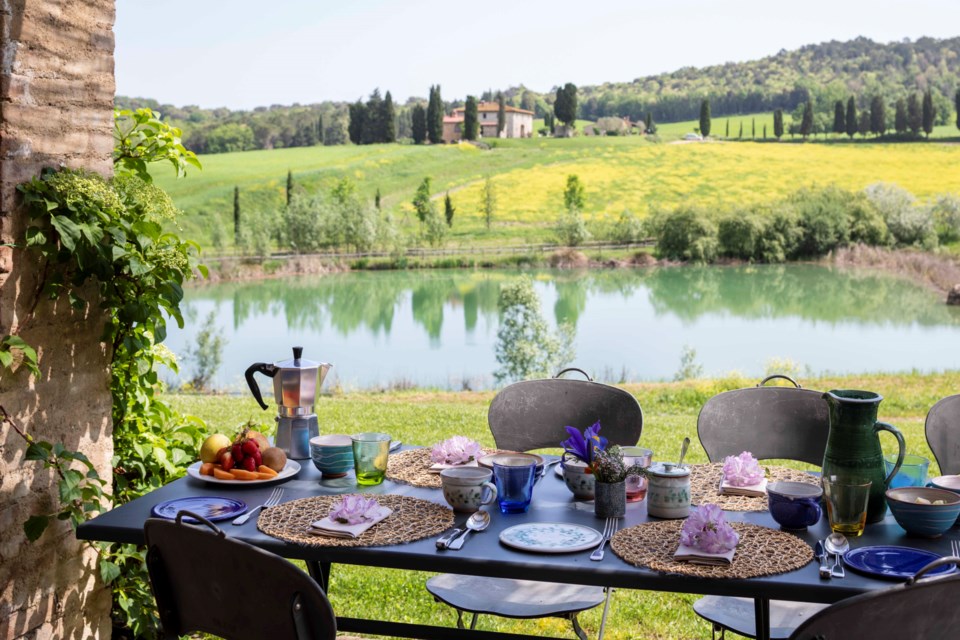Walking along a gravel path in the Tuscan countryside, it doesn’t seem real that this all exists. Lush, rolling hills surround me as far as I can see, the golden sunset casting amber hues over the folds in the land. Seventeenth-century buildings turned into maisonettes dot the pathway, each with its own history: there are former barns and stables, a guard’s home, and the old pigeon coop, just to name a few. Ivy crawls across many of the stone structures, and lilac butterfly bushes dance with the breeze.
I’m at Borgo Pignano, a 750-acre estate set in a 13th-century hamlet, complete with an 18th-century villa and English gardens, an organic farm, centuries-old cottages and farmhouses, an infinity pool carved from an ancient limestone quarry, an on-site restaurant, olive groves, a vineyard, a spa and numerous experiences that make guests at the estate want to stay put. It’s true — many guests choose to stay on-site for horseback riding, dips in the pool, painting and cooking classes, and wine tastings. But it’s the sustainability efforts that have me wanting to peek at every corner of Borgo Pignano.
Here, the goal is transformative impact, which happens in numerous forms. Borgo Pignano is a Beyond Green property, which means that the estate and all other properties within the property portfolio must meet more than 50 sustainability indicators, including contributing to conservation organizations, hiring people from the local communities, buying goods and services from local businesses and more. It’s about so much more than eliminating single-use plastics, and the property is doing everything it can to create a sustainable haven.
After a horseback ride through the estate one morning, I stop at the vineyard for a peek at Borgo’s grape production. Rows of vermentino, abrusco, malvasia nera and ciliegiolo grapes rest against a backdrop of tan Tuscan hills sprinkled with spindly Mediterranean cypress trees. Enzo Maccioni, the farmer and gamekeeper at Borgo Pignano, tells me a bit about this young vineyard, which was planted in 2015.
At about five acres, the vineyard produces 14,000 bottles per crop, and before the grapes went in, the soil here was used for years by horses, meaning it’s naturally fertilized. “The sun and the breeze are also helping a lot,” Maccioni says as he points to the hills in the west, which are further bounded by the Ligurian Sea.
No pesticides or chemicals are used on the vines, and a different approach is taken to keep bugs off the grapes: rose bushes. Each grape row has a rose bush in front of it, and Enzo explains that the roses attract bugs, which makes them stay away from the vines. What’s more, Borgo Pignano is using its gray and waste waters in a phytodepuration system to irrigate the vineyard. Gray and waste waters are filtered through a tank filled with pipes and reeds that naturally purify the water, and the purified water is used to irrigate the vineyard through underground drainage, meaning that nothing goes to waste. The harvest is usually in September, when white, red and rose wines are made.
____
En route to the garden, I spot colorful boxes scattered across the estate. They look almost like shoe boxes, but I learn they contain bee hives, which are vital to the ecosystem not only of Borgo Pignano but also of the world.
Honeybees provide about 80% of the world’s pollination. Fruits, vegetables, flowers and nuts all have bees to thank for their pollination. Our modern world, however, is wreaking havoc on bees, with colonies collapsing everywhere from pesticides, drought, air pollution, habitat destruction and more. Borgo Pignano is doing its part to create a bee haven, and the honeybees produce millefiori honey, which is used in dishes in the restaurant. The beehives are near areas where bees can easily access flowers for pollination, including the vegetable garden, which contains seasonal produce that is also used in the restaurant, such as strawberries, artichokes, tomatoes, saffron, radishes and asparagus. Resident chickens and horses help fertilize the garden grounds, and ponds and harvested rainwater help water the garden.
The estate also produces its own organic flour from grains grown on-site from heritage seeds. Irrigated by natural and manmade lakes across the estate, the grains are harvested and then ground with Borgo’s own flour mill. In-house herbalist Lisabetta Matteucci, who tells me to call her “Betty,” shows me the old-school flour mill at the workshop, where she demonstrates putting in the grains and shows me the final powdery product. The flour is then used in pastas, breads and pizzas throughout Borgo Pignano, and I use it in a cooking class to make the truffle-and-cheese ravioli that dreams are made of.
___
While visiting the workshop with Matteucci, I spy bowls of vibrant dried flowers everywhere. It’s a botanist’s fantasy, full of fresh flowers in vases, dried bundles of lavender, fragrances that are used in soaps and bath products across the property, an array of healing tonics and teas, and jarred honey and jams straight from Borgo’s honeybees and produce. Here, Matteucci creates the products enjoyed by guests, and she even makes me a homemade salve to take home, which she says works for healing wounds or as a lip balm. She also shows me how to make silk scarves hand-printed with the shapes of various flowers and leaves and has me grind down some flower petals using a mortar and pestle for her next project.
Over a fresh bowl of pasta at dinner, with a glass of wine made from estate grapes, I realize just how special this little slice of Tuscany is. Across the region, you can find great wine, great food and great hospitality, but it’s not as common to find a place working to create both a memorable experience for guests and a sustainable oasis where everything has not only a place, but a place to thrive. And for me, that’s amore.
Don't miss anything Local. Sign up for our free newsletter.




